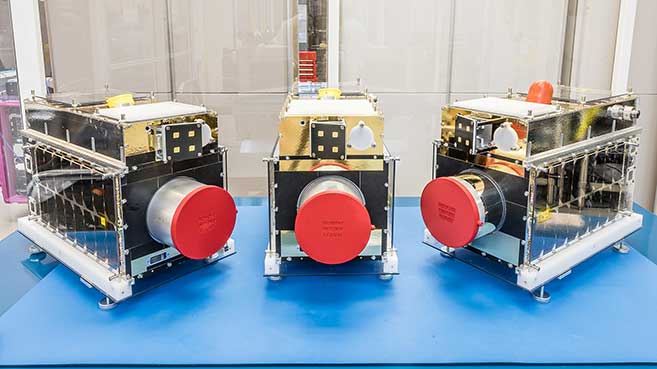Space Flight Laboratory (SFL) and GHGSat Announce Successful Testing of Three New Greenhouse Gas Monitoring Satellites

TORONTO, Ontario, Canada, 5 May 2022 – Space Flight Laboratory (SFL) and GHGSat Inc. today announced the successful completion of laboratory testing on the GHGSat-C3, C4, and C5 microsatellites at SFL’s facility in Toronto. Canadian based company GHGSat is expanding its constellation of methane monitoring satellites, expected to launch in spring/summer 2022.
“SFL is proud to play a role in the important work GHGSat is doing to provide greenhouse gas monitoring as a commercial service,” said SFL Director Dr. Robert E. Zee. “The GHGSat microsatellites are able to detect and measure methane emissions from sources on the Earth’s surface that are 100 times smaller than those identified by other satellites.”
The three new GHGSat commercial high-resolution satellites will join the company’s current constellation already in orbit – GHGSat-D (Claire), GHGSat-C1 (Iris) and GHGSat-C2 (Hugo) – also built by SFL. Each microsatellite includes attitude control technology developed by SFL that enables the low-inertia platforms to point their onboard sensors precisely at emissions sources.
“We see emissions today. With a growing satellite constellation, GHGSat will be able to monitor even more methane emission sources around the world, offering more data and statistics on growing climate changes and trends. We have the data to make a difference,” says Stephane Germain, GHGSat CEO.
All the GHGSat high-resolution satellites that have been, or are being, developed by SFL are built on the SFL 15-kilogram Next-generation Earth Monitoring and Observation (NEMO) microsatellite platform.
Testing of the GHGSat-C3, C4, and C5 satellites – named Luca, Penny, and Diako – commenced earlier this year following delivery of the methane-detecting sensors from ABB Measurement & Analytics Canada. SFL integrated the sensors into the NEMO buses and initiated a series of tests for each spacecraft and its subsystems, which included Long Form Functional Test, Electromagnetic Compatibility, Vibration, and Thermal Vacuum.
SFL also performed successful vibration testing of the XALT launch adapter which will mount the three microsatellites and their accompanying XPOD Delta deployer to a single 15-inch port on the launch vehicle. The XALT adapter and XPOD deployer are systems designed and developed by SFL to ensure the satellites separate safely from the launch vehicle.
“Throughout the testing, GHGSat-C3, C4, and C5 have met their design goals and are performing well above their baselines in all aspects,” said Dr. Benoit Larouche, SFL Mission Manager. “The satellites have been shipped to the launch site.”
SFL is a unique microspace provider that offers a complete suite of nano-, micro- and small satellites – including high-performance, low-cost CubeSats – that satisfy the needs of a broad range of mission types from 3 to 500 kilograms. Dating from 1998, SFL’s heritage includes 55 operational successes and 37 currently under construction or awaiting launch. These missions relate to Earth observation, atmospheric monitoring, ship tracking, communication, radio frequency (RF) geolocation, technology demonstration, space astronomy, solar physics, space plasma, and other scientific research.
In its 24-year history, SFL has developed CubeSats, nanosatellites, and microsatellites that have achieved more than 186 cumulative years of operation in orbit. These microspace missions have included SFL’s trusted attitude control and, in some cases, formation-flying capabilities. Other core SFL-developed components include modular (scalable) power systems, onboard radios, flight computers, and control software.
About Space Flight Laboratory (SFL)
SFL generates bigger returns from smaller, lower cost satellites. Small satellites built by SFL consistently push the performance envelope and disrupt the traditional cost paradigm. Satellites are built with advanced power systems, stringent attitude control and high-volume data capacity that are striking relative to the budget. SFL arranges launches globally and maintains a mission control center accessing ground stations worldwide. The pioneering and barrier-breaking work of SFL is a key enabler to tomorrow’s cost aggressive satellites and constellations.
Download the specification sheet for all SFL platforms here.
SFL Contact:
Dr. Robert E. Zee
SFL Director
1-416-667-7400
info@utias-sfl.net
Follow SFL on Twitter @SFL_SmallerSats
About GHGSat Inc. (https://www.ghgsat.com/en/)
GHGSatuses its own satellites and aircraft sensors to measure greenhouse gas emissions directly from industrial sites, providing actionable insights to businesses, governments, and regulators. With proprietary remote-sensing and patented technology, GHGSat enables strategic decision-making through monitoring and analytics services, with better accuracy, more frequently, and at a fraction of the cost of other technologies. www.ghgsat.com
GHGSat Contact:
Sevana Jinbachian, GHGSat Communications and Events Specialist
